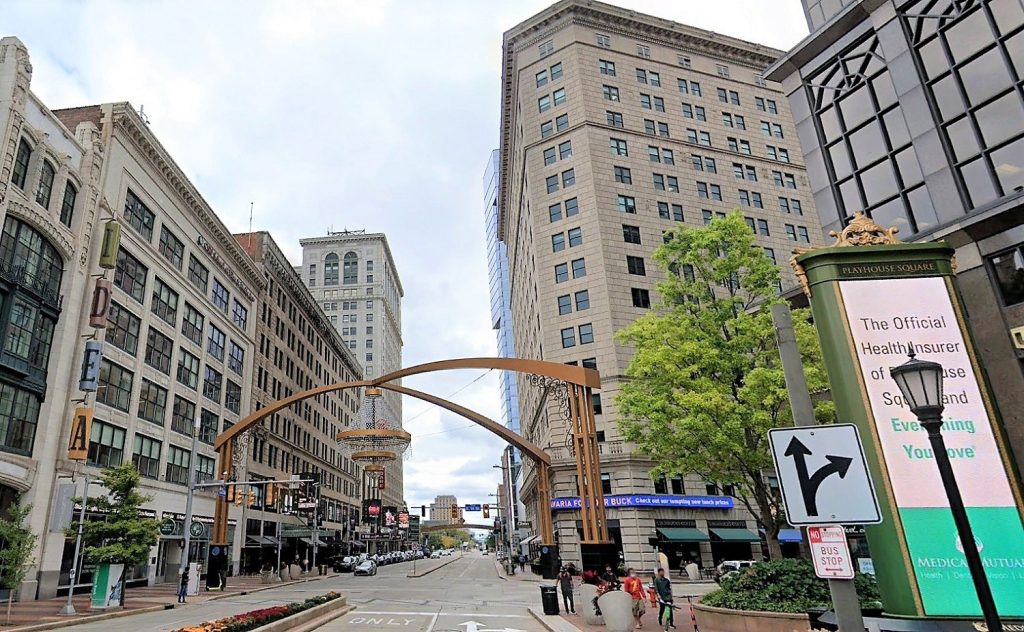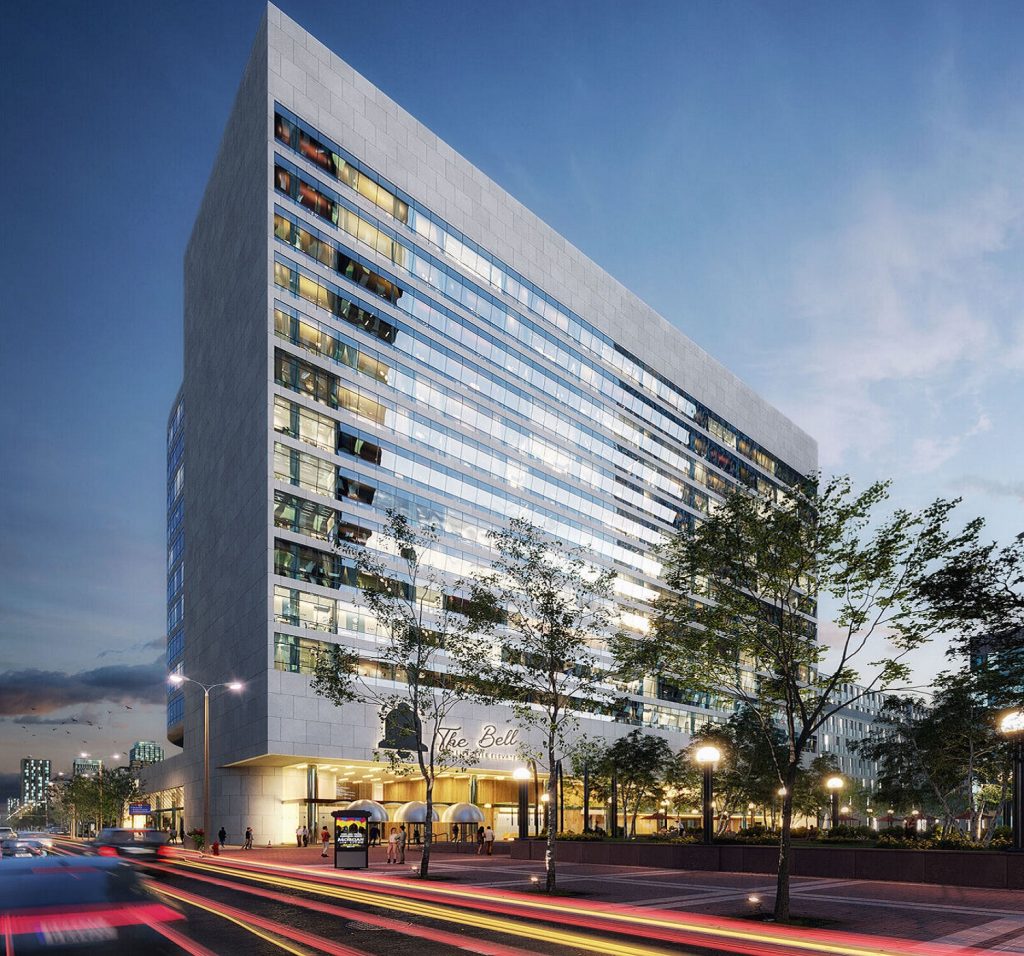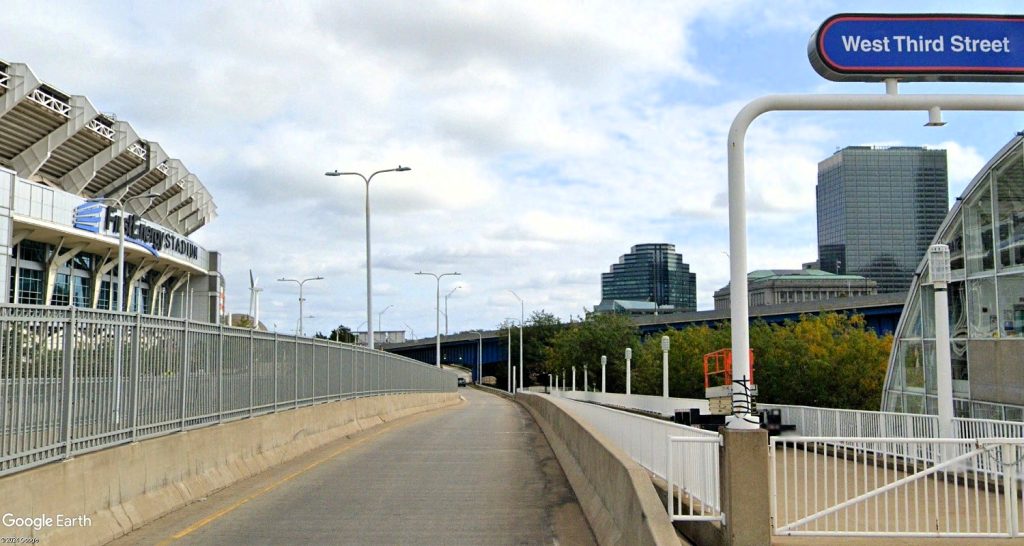
Looking east from West 3rd Street, there are multiple barriers between Downtown Cleveland’s central business district, at right, and the Lake Erie waterfront, to the left. They include the Shoreway highway, visible above the trees, and the access ramps to it are in the foreground. Most of these features are due to go away if the city is able to secure federal funds to afford it (Google). CLICK IMAGES TO ENLARGE THEM.
ODOT supports grant, Shoreway boulevard

In one of the largest single federal grant requests ever by the city of Cleveland, Mayor Justin Bibb’s administration is seeking $268 million from the federal government to tackle four main lakefront improvement projects simultaneously. The projects, which include reconfiguring the Shoreway highway into a boulevard with intersections, have the backing of the Ohio Department of Transportation (ODOT), Cuyahoga County and others.
City officials have been stingy with information about the funding application, which is to a three-year-old program at the U.S. Department of Transportation (USDOT) for supporting large, complex, infrastructure projects. The reason is their chance of winning the grant is far from guaranteed so they are trying to manage expectations. But their desire to aggressively address multiple lakefront components at once is intriguing.
“We did submit an application to support the construction of the land bridge, roadway reconfiguration, multimodal hub, and streetscape enhancements,” confirmed city Press Secretary Marie Zickefoose.
The city is seeking the $268 million from the USDOT’s National Infrastructure Project Assistance Program which funds no more than 60 percent of a project’s cost. The math says the four lakefront elements would have a total cost of not less than $446.67 million. If it’s more than that, it would have to come from other sources and programs.
Portions of the lakefront project could be funded by one or both of the program’s Mega and INFRA accounts. Combined, those accounts offer $4.4 billion to applicants on a competitive basis this year. Awards could be announced by the end of summer. Non-federal funding resources could include the city’s new downtown tax-increment district, state capital budget funds, ODOT, Greater Cleveland Regional Transit Authority (GCRTA) and more.
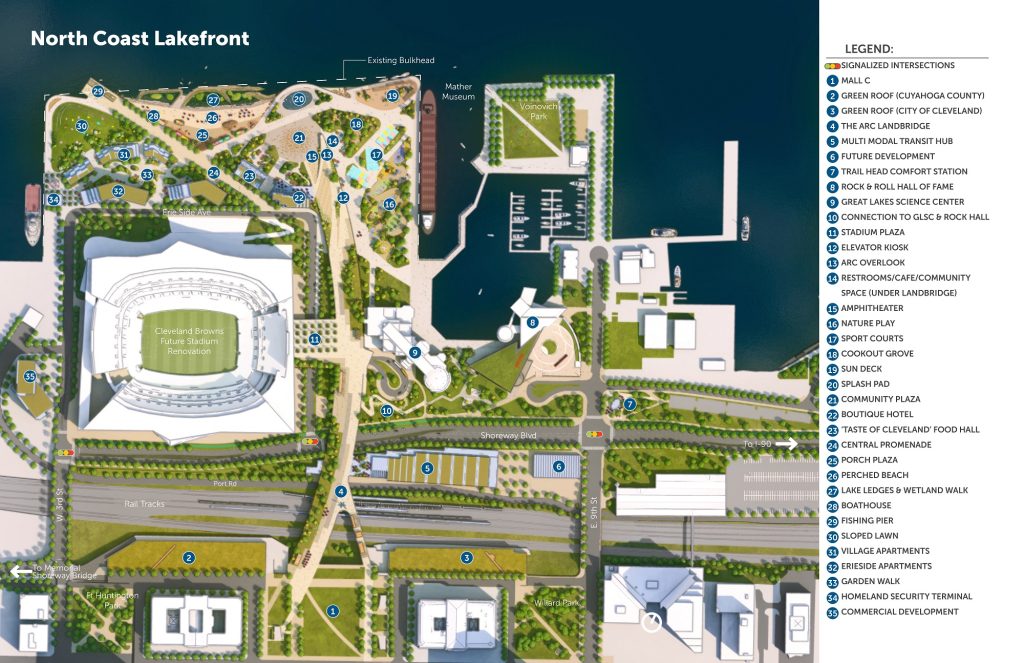
Two of the largest components of the city’s lakefront plan are the arcing, north-south North Coast Connector landbridge and the east-west Shoreway Boulevard. They and the multimodal transit hub and streetscape improvements to West 3rd Street, East 9th Street and others could be funded by a single federal grant, an application for which is now pending (FO).
According to a 2021 Transportation Review Advisory Council document, the estimated cost of the 120-foot-wide land bridge, called the North Coast Connector, is $229.1 million. It would effectively extend downtown’s malls over the lakefront railroad tracks and Shoreway to the water’s edge of Lake Erie.
ODOT provided $6.5 million in planning funds two years ago to help design the connector and a reconfiguration of nearly 2 miles of Ohio Route 2, called the Cleveland Memorial Shoreway. That lakefront design work included multiple public meetings, surveys and workshops to identify design alternatives and come up with a preferred option.
The proposed reconfiguration includes demolishing Shoreway bridges east of West 9th Street and replacing the highway with a landscaped boulevard having intersections at West 3rd Street, Erieside Avenue, East 9th Street and an extended East 18th Street, according to city lakefront plans.
A new, grade-separated Port Access Roadway along the railroad tracks and a redesigned West 3rd bridge over the tracks and port road would be built. A dollar amount for the Shoreway reconfiguration is not available, but it may be more expensive than the North Coast Connector at full build-out.
ODOT’s support for reconfiguring the Shoreway is a surprise considering the highway-focused department opposed a similar reconfiguration for the West Shoreway near Edgewater Park more than a decade ago. The end result was an odd compromise — a landscaped roadway still-designed for highway speeds but with a 35-mph speed limit.

Many Clevelanders who were old enough to remember the Great Lakes Exposition of 1936-37 said it was the city’s best use of its downtown lakefront before or since. Immediately after, the Cleveland Memorial Shoreway was built between the railroad tracks and old Municipal Stadium, a pedestrian bridge over the tracks was removed, and the exposition buildings were razed for stadium parking (CSU Cleveland Press Collection – The Michael Schwartz Library).
That would not be the case downtown. The reason for ODOT’s support is the Shoreway is Cleveland’s oldest freeway. Dating from the late-1930s, it doesn’t meet modern highway design and safety standards including entrance and exit ramps spaced too closely together, a lack of breakdown lanes on either side of the roadway and other shortcomings.
There isn’t room downtown to address those shortcomings with a modern highway without reducing access points to downtown streets, so a boulevard approach was favored by ODOT, according to a letter written May 6 by ODOT Director Jack Marchbanks. NEOtrans secured a copy of the letter through a public records request.
“The North Coast Connector is critical, enabling infrastructure that will link Downtown Cleveland’s business district with its lakefront,” Marchbanks wrote. “It will mitigate or eliminate the barriers to the lake and improve regional transportation infrastructure through the construction of a 120-foot-wide land bridge, removal of substandard ramps, and the major reconfiguration of a nearly two-mile segment of freeway into a modern, safe, and efficient multimodal boulevard.”
Among the most interested persons seeing Cleveland’s lakefront plans get federally funded is Cuyahoga County Executive Chris Ronayne. He was the city’s planning director for then-Mayor Jane Campbell in 2004 when Cleveland advanced one of its most comprehensive lakefront plans in its history. But Campbell lost her reelection bid the next year to Frank Jackson who didn’t prioritize lakefront improvements during his 16 years in office.
“Converting the Shoreway through downtown to a slower-speed, crossable boulevard has been a long time coming,” Ronayne told NEOtrans. “We had it in the 2004 Lakefront Plan and two decades hence the city of Cleveland and ODOT are aligned. This will accelerate lakefront development and more walkability between downtown and the lakefront. It’s a win-win.”
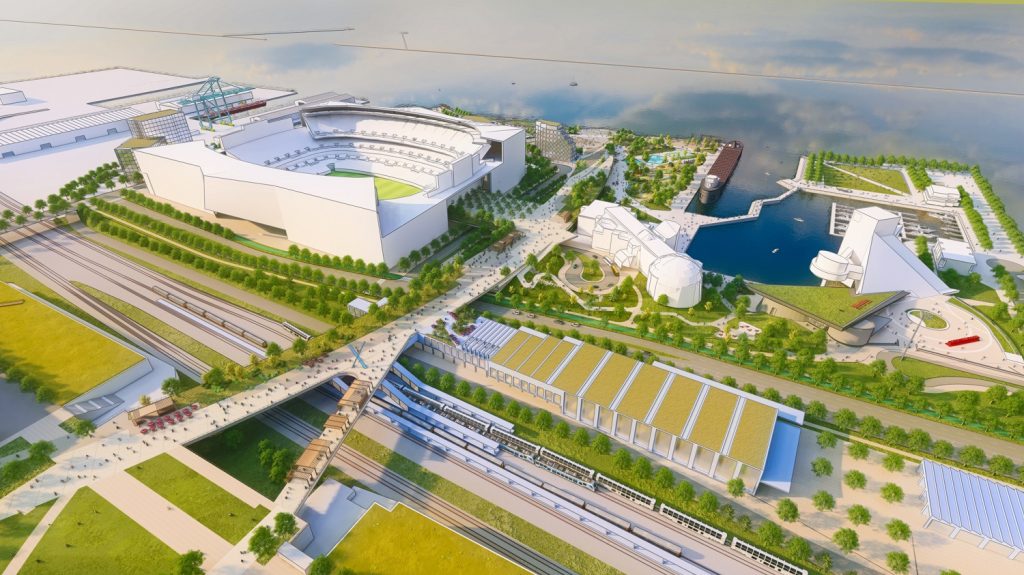
The North Coast Connector landbridge is one of the dominant lakefront features in this view as is the multimodal transit center attached to it. The Shoreway Boulevard does not stand out and that’s the goal of city planners. Cleveland Browns Stadium is another dominant feature although city planners are designing land use options for its site in case the football team decides to build a domed stadium in Brook Park (FO).
The third feature in the city’s grant application is a multimodal transportation center. According to Marchbanks, however, the funding request won’t include everything physically necessary to accommodate all of the modes desired — a larger, more spacious Amtrak passenger rail station, combining GCRTA’s West 3rd and East 9th Waterfront Line light-rail stations into a single facility, hosting GCRTA and other regional transit buses and possibly Greyhound/Barons buses, too.
He noted the funding will support “The foundation for an expanded multimodal transportation facility that integrates interstate and regional rail and bus service.” The multimodal transit center is proposed by the city to measure about 150,000 square feet, which is big enough to accommodate a roughly 500-space parking garage. Based on a cost of $25,000 to $50,000 per parking space, the new facility could cost $12.5 million to $25 million.
The design of the rail and bus facilities — platforms, elevators/stairwells, waiting room, additional tracks — has not yet been undertaken. That could come out of a new, five-year, $300 million Great Lakes Stations Improvement initiative Amtrak is requesting of Congress. The first year is proposed to have $25 million it in for pre-construction activities — designs, environmental documentation and permitting.
The last feature in the city’s grant application is for streetscape enhancements of roadways in the affected area — West 3rd, East 9th, Erieside, and Shoreway Boulevard. The improvements won’t be limited to landscaping along sidewalks.
Based on public input given at lakefront listening sessions and to a Downtown Livability and Transportation Study by the Northeast Ohio Areawide Coordinating Agency, downtown residents, workers and visitors said they wanted safer places to walk and ride bikes. Some considered the streets near the lakefront to be designed more for cars and thus dangerous for people, surveys showed.
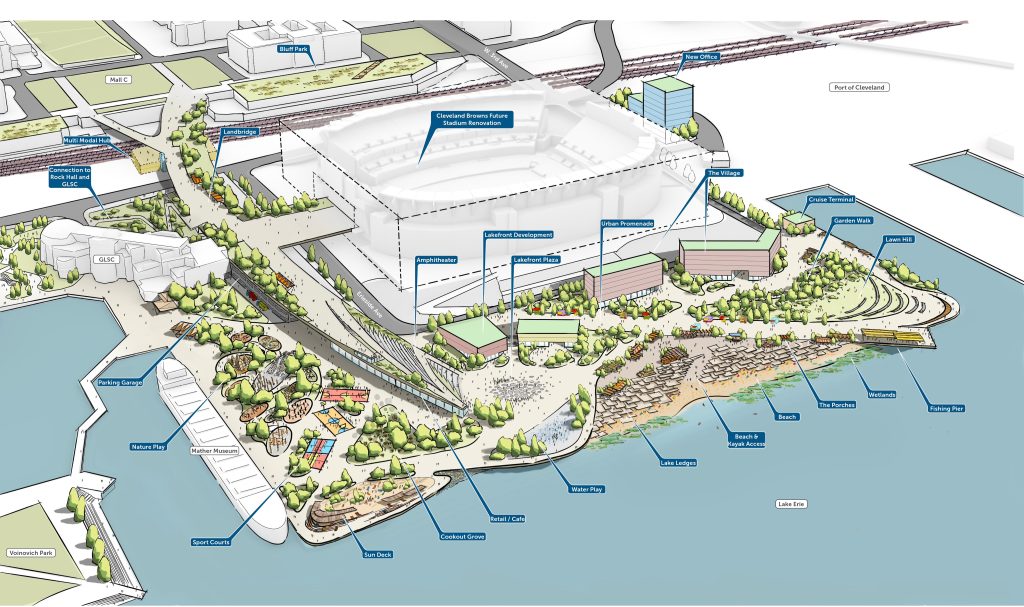
A rendering from an aerial view of a redeveloped Downtown Cleveland lakefront. It’s an earlier version which shows the Shoreway boulevard crossing the lakefront railroad tracks on its own, new bridge just west of West 3rd Street. Instead, the current plan is for the existing, lightly used West 3rd bridge to be redesigned to share traffic with the new boulevard (FO).
The city is making some interim improvements to the lakefront’s public spaces between now and May 2025. North Coast Harbor is getting a $4.99 million makeover, resulting from Bibb’s Reimagining Downtown Cleveland Plan. The project encompasses the area north of Erieside and East 9th, including Voinovich Park, surrounding walkways, the Great Lakes Science Center and the Rock and Roll Hall of Fame where a $100 million expansion is underway.
Of course, the 800-pound gorilla in the room is what will happen with Cleveland Browns Stadium and the 31 acres of lakefront land on which it sets. The open-air stadium could get reconstructed for $1.2 billion or it could be demolished in favor of a new $2.4 billion domed stadium in suburban Brook Park.
In the event the latter occurs, the city’s lakefront masterplan consultant James Corner Field Operations of New York is developing alternative concepts for reusing that land. Because the consultant was asked to do that and other additional work, City Council authorized another $140,000 to the firm in April.
Also, Cleveland City Council is currently reviewing an amendment to an existing ordinance that would let lakefront construction consultant Osborn Engineering Company transition from providing planning and engineering services to assisting in the construction of lakefront infrastructure.
Text added to its authorization includes “determining the method of making the public improvement of constructing the (Lakefront Pedestrian) bridge and authorizing the director to enter into one or more public improvement contracts for the making of the improvement.”
END


